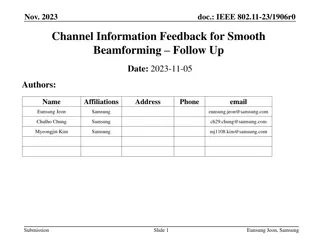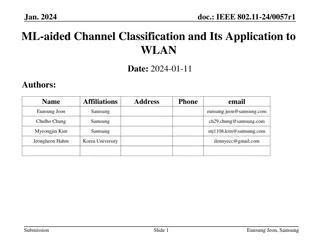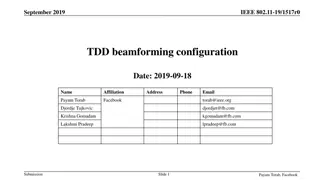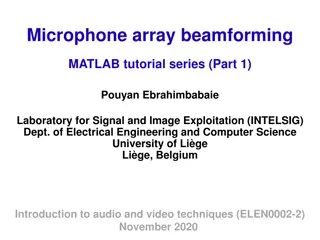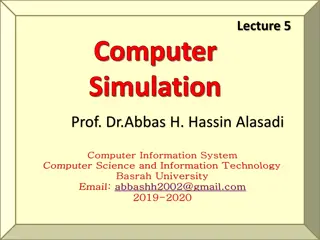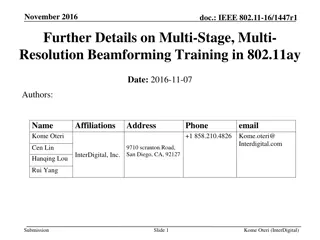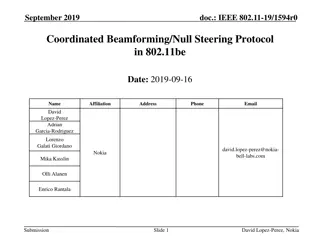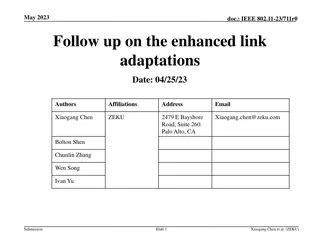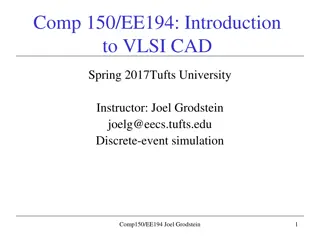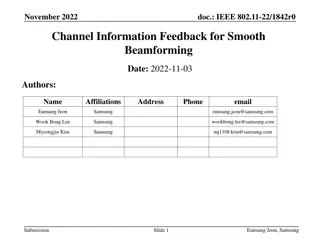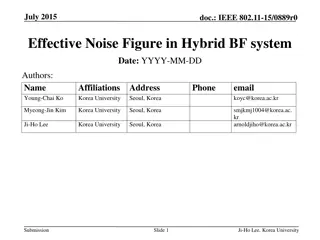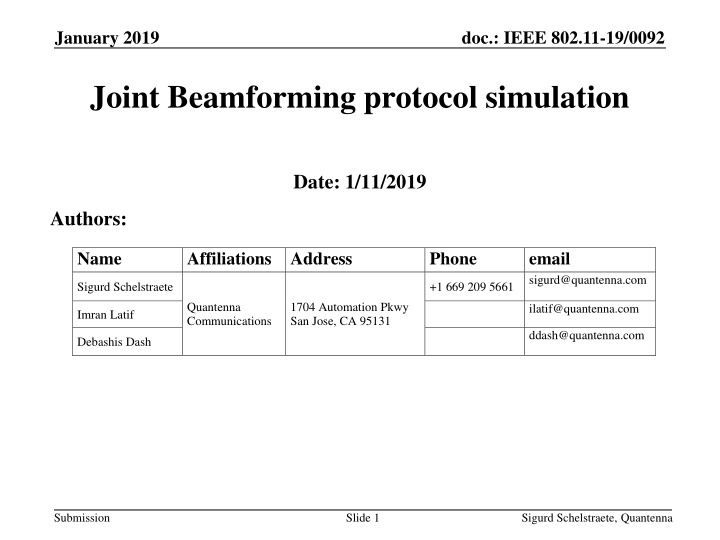
IEEE 802.11-19/0092 Joint Beamforming Protocol Simulation Report
Explore the simulation results of a joint beamforming protocol in IEEE 802.11-19/0092 document for multi-AP coordination, synchronization, and backhaul mechanisms. The analysis includes performance evaluations of mesh versus wired solutions in constrained MU-MIMO scenarios.
Download Presentation

Please find below an Image/Link to download the presentation.
The content on the website is provided AS IS for your information and personal use only. It may not be sold, licensed, or shared on other websites without obtaining consent from the author. If you encounter any issues during the download, it is possible that the publisher has removed the file from their server.
You are allowed to download the files provided on this website for personal or commercial use, subject to the condition that they are used lawfully. All files are the property of their respective owners.
The content on the website is provided AS IS for your information and personal use only. It may not be sold, licensed, or shared on other websites without obtaining consent from the author.
E N D
Presentation Transcript
January 2019 doc.: IEEE 802.11-19/0092 Joint Beamforming protocol simulation Date: 1/11/2019 Authors: Name Affiliations Address Phone email sigurd@quantenna.com ilatif@quantenna.com Sigurd Schelstraete +1 669 209 5661 Quantenna Communications 1704 Automation Pkwy San Jose, CA 95131 Imran Latif ddash@quantenna.com Debashis Dash Submission Slide 1 Sigurd Schelstraete, Quantenna
January 2019 doc.: IEEE 802.11-19/0092 Introduction EHT has been discussing various levels of multi-AP coordination Coordinated vs. joint operation See [1], [2], [3] for proposed scenarios and terminology Constrained Distributed MIMO ([4], [5]) was proposed to allow synchronization and CFO correction to be addressed through wireless protocol Submission Slide 2 Sigurd Schelstraete, Quantenna
January 2019 doc.: IEEE 802.11-19/0092 Constrained MU-MIMO One AP acts as Master AP and can be heard by all other APs ( Slave APs ) Each joint transmission is preceded by a Slave Trigger from the Master AP This allows slave APs to correct for phase and timing drift and CFO Similar in function to Trigger frame in UL MU transmission in 11ax Simulations on required and achievable synchronization in have been presented in [6], [7] Submission Slide 3 Sigurd Schelstraete, Quantenna
January 2019 doc.: IEEE 802.11-19/0092 Constrained MU-MIMO (2) Multi-AP operation requires all APs (Master + Slaves) to share data to the final recipient prior to the joint transmission Submissions so far have not explicitly addresses this Backhaul mechanism [8] suggest a Wi-Fi/repeater like approach (Wi-Fi backhaul) [5] mentions both mesh and wired solutions Submission Slide 4 Sigurd Schelstraete, Quantenna
January 2019 doc.: IEEE 802.11-19/0092 Analysis Purpose of this submission: Provide network simulation results on the expected performance of various backhaul mechanisms mesh vs. wired solutions Results account for the protocol overhead inherent in the various proposals Initial results are shown for joint Beamforming Submission Slide 5 Sigurd Schelstraete, Quantenna
January 2019 doc.: IEEE 802.11-19/0092 Joint Beamforming scenario The following scenario was discussed in [8] AP2 Data frame at T2 AP1 STA AP1 is the master AP Transmission at time T1 constitutes the backhaul Data is communicated between AP1 and AP2 Transmission at time T2 is the joint transmission Both AP1 and AP2 send data to the STA Submission Slide 6 Sigurd Schelstraete, Quantenna
January 2019 doc.: IEEE 802.11-19/0092 Joint Beamforming protocol Adapted from [8] JTA frame + Data frame are the backhaul transmission Combined into single frame for the simulations presented here JT Trigger frame announces the joint transmission allows AP2 to synchronize STA AP1 AP2 JTA frame Wired or wireless Data frame JT Trigger frame Data frame using joint transmission Submission Slide 7 Sigurd Schelstraete, Quantenna
January 2019 doc.: IEEE 802.11-19/0092 Simulation setup AP1 and AP2 are in fixed locations, 40 ft apart APs are 4x4, STA is 2x2 STA position is changed to see performance in each position Covering an area of roughly 200 x 200 ft Calculate throughput for each position For joint BF, MCS for each link is based on combined RSSI with additional BF gain See [9] for details on BF gain PHY layer is abstracted using RSSI vs. Throughput measurements between a 4x4 AP and a 2x2 STA MAC overhead is fully accounted for CSMA, ACK, joint transmission protocol, Submission Slide 8 Sigurd Schelstraete, Quantenna
January 2019 doc.: IEEE 802.11-19/0092 Case 1: Wi-Fi backhaul Data for STA is communicated between AP1 and AP2 using Wi-Fi Using MCS appropriate for the AP1-AP2 link Compare throughput of joint BF with throughput of direct AP1->STA transmission Airtime usage illustration: Submission Slide 9 Sigurd Schelstraete, Quantenna
January 2019 doc.: IEEE 802.11-19/0092 Results for Case 1 Wireless Backhaul adds significant protocol overhead Throughput to STA much lower than direct transmission in most of the space Submission Slide 10 Sigurd Schelstraete, Quantenna
January 2019 doc.: IEEE 802.11-19/0092 Full results for Case 1 Submission Slide 11 Sigurd Schelstraete, Quantenna
January 2019 doc.: IEEE 802.11-19/0092 Case 2: Wired backhaul Data for STA is communicated between AP1 and AP2 using a different cabled network We compare the performance of joint BF with coordinated transmission (either AP1 or AP2, depending on STA position) Wired backbone is available Airtime usage illustration: Submission Slide 12 Sigurd Schelstraete, Quantenna
January 2019 doc.: IEEE 802.11-19/0092 Results for Case 2 Impact of residual protocol overhead No improvement inside BSS Improved performance at cell edge (see [9]) Submission Slide 13 Sigurd Schelstraete, Quantenna
January 2019 doc.: IEEE 802.11-19/0092 Conclusions Wireless backhaul communication between APs (Case 1) drastically reduces performance Performance similar to repeater mode Speed could be increased by higher MIMO orders (eg 8x8) For good performance, Joint BF requires APs to be connected by a backhaul other than Wi-Fi Overhead from JT Trigger frame still has non- negligible impact on performance When a wired backhaul is present, coordinated operation may outperform joint operation Submission Slide 14 Sigurd Schelstraete, Quantenna
January 2019 doc.: IEEE 802.11-19/0092 Other Questions What is the impact of sounding overhead? Not considered in the overhead calculation What is the impact on MU-MIMO performance? How does interference of joint AP transmission impact OBSS? BF gains in distributed antenna cases need to be better understood Submission Slide 15 Sigurd Schelstraete, Quantenna
January 2019 doc.: IEEE 802.11-19/0092 References [1] Discussions on Multi-AP Coordination, 802.11-18/1509 [2] Terminology for AP Coordination, IEEE 802.11-18/1926r2 [3] Considerations on AP Coordination, IEEE 802.11-18/1576r1 [4] Distributed MU-MIMO and HARQ Support for EHT, IEEE 802.11-18/1116r0 [5] Constrained Distributed MU-MIMO, IEEE 802.11-18/1439r0 [6] Initial Distributed MU-MIMO Simulations, IEEE 802.11- 18/1962r0 [7] AP Coordinated Beamforming for EHT, IEEE 802.11-18/1510r1 [8] Consideration on multi-AP coordination for EHT, IEEE 802.11- 18/1982r0 [9] Beamforming Gain for Distributed MIMO, IEEE 802.11-19/xxxx Submission Slide 16 Sigurd Schelstraete, Quantenna

